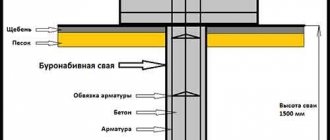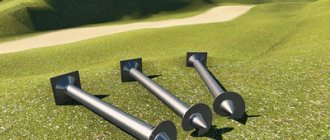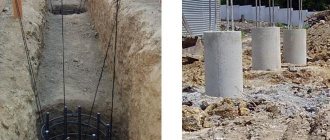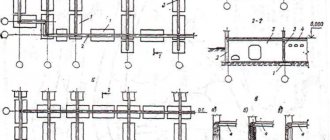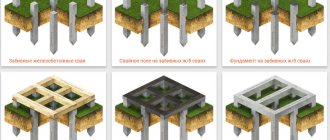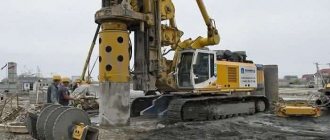Types of pile foundations may vary depending on the characteristics of the landscape, soil and the structure itself. But in any case, this type of support structures significantly reduces construction costs compared to the use of poured foundations that go underground. In many cases, various types of piles are the only solution in the construction of structures under difficult conditions. Pile structures have their advantages and some disadvantages, so even the slightest nuances of their construction are taken into account in the design.
Main types of pile structures
Types of pile foundations differ according to the types of piles and grillages. But the basic principle of using this type of foundation is that the support of the structure receives adhesion to the ground due to the presence of vertically located structural elements in it, that is, piles.
Based on the type of work, foundations are divided into the following types:
- Rack piles. Their task is to take on the main load from the weight of the entire structure. Such piles transfer the weight of the structure to the ground. This is the most common type of piles; their material and design provide maximum strength, reliability and durability, since they account for about 85% of the total mass of the building. This type of foundation provides virtually no settlement and is able to withstand significant loads over a long period.
- Hanging piles. They, as a rule, have a relief surface combined with an increased lateral area. According to the principle of action, they can be compared to a nail hammered into a solid foundation. A striking example of this type of foundation can be given using screw piles. Their use becomes advisable in cases where strong soil lies in the surface to a considerable depth, then hanging ones will be able to perform their function without immersing into the ground over a long distance.
Construction of a foundation on piles
A pile is a rod on which the foundation will subsequently be supported. It can be immersed in the ground in finished form, or made directly in the ground. The main purpose of the element is to transfer load to the ground both through lateral friction and through the lower end.
Components of a pile foundation
A pile foundation consists of several components. Its design may vary depending on the type of materials used and other factors, but in general it looks like this:
- piles immersed in the ground;
- in the upper part they are connected by a grillage, which can consist of beams or slabs and is located above the ground level.
What does a grillage on piles look like?
Types of grillages for pile foundations: prefabricated, monolithic, monolithic-prefabricated. In cases where the head of the pile is its continuation and is connected to other columns, there is no need to make a grillage.
In all types of foundations, the grillage serves to uniformly transfer the load from the building to the piles, and from them to the ground.
Reinforced concrete piles
Piles can be delivered to the construction site ready-made, in the form of beams, or poured into formwork mounted in a drilled well.
Pile design types can be round or polygonal, with pointed lower ends. The length reaches 16 m, the cross-sectional size is from 20 to 40 cm.
The most common products are square-section, as they are less labor-intensive and more technologically advanced to manufacture.
Classification by material type
To determine what types of piles there are, you should consider in more detail their classification by type of material. The durability, reliability, and resistance to external irritants of the foundation being built will depend on its choice.
Wooden
Products are made primarily from the following types of wood:
- pine, spruce;
- oak;
- cedar;
- larch or fir.
Wooden piles are either solid or spliced along their length; in the second case, the logs are connected using metal plates.
At a lower price for wood products, it is important to consider that they can withstand less load compared to reinforced concrete or iron counterparts. Most often, wooden piles are used in the construction of temporary structures.
Reinforced concrete
This type of piles has the most common application. They can be either monolithic or prefabricated.
Monolithic structures have different sections: round, square, rectangular. Section parameters – from 20Х to 40Х40. The end immersed in the ground has a pyramidal shape. When driving the foundation, it is additionally protected by a steel shoe. A monolithic structure is almost always strengthened by internal longitudinal reinforcement. To increase the strength of the pile, it can have transverse reinforcement made of low-carbon wire.
The most common type of reinforced concrete piles
Prefabricated piles are assembled from tubular reinforced concrete elements. Assembly is carried out in advance at the production site or directly at the construction site.
Driving reinforced concrete piles can be carried out using pile drivers, mobile cranes and other specialized equipment. The less expensive vibration-immersion technology has become widespread.
When driving piles, their upper surface is protected by a triple layer of metal mesh in increments of 5 cm. This measure prevents the destruction of the reinforced concrete product during the transfer of load from the hammer.
Metal
The main advantage of metal or screw piles is the ability to create point-by-point load-bearing capacity in places where the use of reinforced concrete technologies is either impossible due to difficult access or is too expensive. Today, this type of support is used more and more often in civil engineering.
The products are made from solid pipes, tapered on one side. A sheet metal flange is welded to the pipe near the tip. The following types of screw piles exist:
- welded;
- with cast tips;
- Geoscrews.
Application of metal piles
The use of metal piles is advisable in the construction of foundations on difficult soil. With their help, you can significantly save your budget, while achieving maximum quality and structural strength. Foundation construction time and noise are reduced by 2 times compared to reinforced concrete analogues.
Types of piles
Piles are:
- screw - there is a blade at the bottom, thanks to which they can be screwed into the ground,
- shell piles are reinforced concrete hollow elements that are installed with the removal of excess soil, and the cavity is then filled with concrete mortar,
- stamped - cast immediately on site into a prepared well,
- driven ones - made of metal, wood, reinforced concrete, they are driven into the ground using special equipment, while excess soil is not removed.
The ways in which they are installed can be as follows:
- screwing,
- driving,
- boring,
- drilling,
- vibration immersion,
- indentation and others.
In private construction, they usually use types of pile foundations that can be built without the use of heavy equipment and without special skills. Therefore, for low-rise construction, screw and bored types are usually used, less often - driven ones due to the fact that the installation of the latter requires special equipment (pile driving hammer), therefore, the cost of construction increases.
Screw
Screw piles are made from metal pipes. At one end there is an auger that makes it easier to drive them into the ground. To install such a foundation, you need a capstan (hydrocabstan), which allows you to mechanize the installation process and is a device consisting of a hydraulic rotator with a gasoline engine and reaction levers. You can do without it - at the upper end of the pile there is a special hole into which a crowbar or metal pipe is inserted and the pile is wrapped. Typically, two people wrap the pile in this way, and a third controls its verticality.
Also, the companies supplying these products offer installation services, this will save you from great physical effort when tightening or spending money on buying a capstan.
After installation, the piles are cut to the same length, and cement-sand mortar (sand concrete) grade M-300 is poured inside. To connect to the grillage, a cap is placed on top.
Such a foundation can be used on various soils, in areas with differences in elevation, it is built quickly and thanks to this it becomes popular. Screw piles can be reused. The video talks about the pros, cons and features of such a foundation.
Screw piles, if you have a plasma cutting machine, a laser or a hydrocutting machine, and if you have the ability to work with metal, can be made with your own hands. The main difficulty in this case is the manufacture of the auger (blade).
Printed
There are several types of such piles:
- Ostrich piles,
- bored,
- pneumatic,
- frequently rammed and others.
Ostrich piles, proposed in 1899, became the basis for other types of cast-in-place piles. They used casing pipes.
Bored piles
This type is most often used in private construction due to the relative simplicity of the device. To do this, wells are drilled under the foundation, casing pipes made of asbestos cement or roofing material rolled into a tube are lowered into them. Reinforcement is inserted inside the pipe and concrete is poured. Polyethylene or cardboard can also be used as formwork. If the soil is not loose, such piles can be poured without formwork (dry method). In this case, the reinforcement is lowered directly into the well and the solution is poured there. Concrete is reinforced only in the upper 1.5-2 meters.
For greater stability, a heel is made at the bottom of the pile - an extension. To do this, when the solution is poured into the pipe for about 1 m, the pipe is slowly raised until the level of the solution drops to 0.3-0.4 m. In this way, the concrete is connected to the ground, forming a thickening. In addition, laitance penetrates into the soil and makes it stronger.
Bored piles can be used not only to build a new foundation, but also to strengthen an existing one.
Wooden
Wooden piles for foundations are used less often than concrete or steel ones, but this technology also has a right to exist. Now the tree can be treated so that it does not rot in the ground. Wood can be used to make both rack piles, which pass through weak layers of soil and rest on harder ones with better load-bearing capacity, and hanging piles, which work due to the frictional force on the side surface of the pile. The advantages of wooden foundations are:
- environmental friendliness,
- low cost,
- good thermal insulation properties,
- elasticity - after removing the applied pressure, the structure restores its shape,
- ease of installation.
The disadvantage of a wooden foundation is its fragility, especially if soil moisture changes over time. Drying and getting wet quickly destroys the wood.
Light-weight wooden houses and small household or commercial buildings are erected on such foundations.
To install wooden piles, it is very important to know the groundwater level. The lowest point of support should be deeper than the lowest layer of groundwater.
For wooden foundations, durable wood species are used, such as:
- oak,
- pine,
- larch.
The wood is pre-treated with a special solution (creosote, copper sulfate and others) or charred. The following requirements are imposed on the foundation:
- it must rest on solid ground,
- must be buried at least 50 cm below the frost line,
- foundation depth - at least 1.2 m,
- a tree of at least 20 cm in diameter is used.
Wooden piles, in turn, are divided into several types:
- from one log,
- spliced,
- batch.
Spliced piles are made from 2-4 logs. The length of the pile can be from 2 to 12 m. Before installation, the lower end is sharpened, and sometimes (for driving into dense soil) a metal shoe is put on it. A metal hoop (yoke) is put on the upper end. The supports are installed by driving (with a pile hammer or a regular sledgehammer) or by vibrating, and sometimes by pressing. Sometimes concreting is used for strength.
It is advisable to build a house on such a foundation in places where suitable wood grows and where it is harvested, otherwise delivery costs will offset all savings.
Classification according to the method of penetration into the ground
The method of driving a pile depends on the type of product, the material from which it is made and some other factors, for example, the type of soil and groundwater level. To facilitate the construction of a pile foundation in sandy and gravelly soils, the technology of undermining can be used, and for silty-clay soils, well drilling and electroosmosis can be used. But the most commonly used immersion methods are:
- the driving method is implemented using pile hammers;
- vibration immersion is carried out in wet sand conditions;
- pressing into the ground, used in cases where dynamic impact on the ground is unacceptable;
- metal screws are buried in the ground by screwing. This technology is appropriate in soft soils.
In the video below you can see how a reinforced concrete pile is driven:
Metal piles
A rolled profile is used as piles: an I-beam, channel or pipe. Sometimes they are pre-prepared. To do this, weld 2 channels together, thus obtaining a square pipe.
Piles can also be of an open section. They are made by welding corners, rails, I-beams.
Metal is used in cases where it is impossible to install reinforced concrete piles. It is easier to build it up as it goes deeper into the ground.
Metal profiles have high strength, which simplifies their driving into the ground. For a small cross-section, solid inclusions or destroyed rocky soils are not dangerous.
Piles are driven into the ground with a hammer or press. For depths up to 5 m, a hand hammer is sufficient.
Special types of piles among metal products are screw piles. Providing high strength, they are more economical and technologically advanced than reinforced concrete foundations. Piles are hollow pipes with external blades. They are screwed into the soil like screws, preserving its structure and further compacting it. In this case, rotation in the opposite direction is not allowed, so as not to deteriorate the characteristics of the base.
Separation of piles according to manufacturing conditions
There are two main classifications of piles according to the conditions of their manufacture: those produced in production and in the ground. If in the first case the product is immersed in the ground in finished form, then in the second it is manufactured directly at the construction site. Such products are called bored or stuffed.
Driven piles
The first stage of installation of such piles is drilling a well to a certain level. Subsequently, concrete or a reinforced concrete structure is packed into it. Often, an expansion is made in the lower part of the well by drilling the soil or expanding it by intensive compaction of concrete. As a result, the pile will have an expanded heel.
Manufacturing of reinforced concrete piles in the ground
The next step is to strengthen the bed. To do this, crushed stone or slag is poured into the bottom of the well and compacted to strengthen the future pile. The maximum parameters of a bored product are up to 0.5 m in width and up to 50 m in depth.
Then a casing pipe is installed in the well, which will subsequently serve as a foundation. If the pile design requires additional reinforcement, a reinforcement frame is installed in the casing. The pipe has a loose shoe, which forms an expanded heel during the compaction of concrete.
The concrete mixture is poured into the pipe, after which the material is compacted. It is performed by hitting a pipe with a hammer or using vibration stamping technology. The second method is more economical and is being used more and more often today.
Various types of screw pile tips
There are main types of screw pile tips based on the method of connection to the pipe body:
- Tips made from pipe body
- Tips welded to the pipe
The shape of the tips can be:
- Cross-shaped
- Round
- Pipes cut at an angle
- Pointed pipe ends
Typically, cross-shaped tips are made from the pipe itself. To do this, petals are cut out at the end of the pipe and knocked towards the center.
Rice. Cross tip
Round ends are most often made by casting and welded to the end of the pipe.
In addition to pipes with tips, piles without a tip are also used - the body of the pipe can be cut at an angle, or have pointed teeth at the end. Cutting the pipes this way makes it easier to deepen them. The use of such piles is possible in fairly dense soils. In addition, the teeth at the end of the pile help overcome the resistance of soils with a high content of small rocky inclusions.
Threaded tip
Application of figured piles of various types
In particularly difficult conditions, for example, with severe freezing of the soil or excessive load on the soil, the use of piles with various shapes is recommended. They can be either made in the ground or driven in.
The following types of products are distinguished:
- pyramidal;
- trapezoidal;
- diamond-shaped;
- with a wide heel.
Type of piles with a widened heel
All these types of piles are used only as hanging posts, as they allow full use of the supporting capacity of the soil. The first three types of products are used in conditions of severe soil freezing to minimize tangential forces during soil heaving.
Piles with a widened heel are used in soft soils, under which denser layers lie. Such products are used as racks and can ensure the strength and reliability of the foundation even on unstable soils.
Application area
Pile foundations are used for different types of buildings bearing certain loads. Therefore, for a high-quality foundation, it is necessary to choose the right type of piles. Let's consider the purpose and types of piles:
- Wooden. They are used in the construction of cottages, small bridges or temporary buildings. Products are immersed by pressing, hammering, and vibrating.
- Metal. They are distinguished in the form of sheet piles, I-beams and other types of rolled profiles. Screw products with high strength properties are very popular. Immersion into the soil is carried out by screwing the product into the ground manually or using special equipment.
Their advantage is the ability to use such building elements on any terrain. Such elements are used for the manufacture of foundations for power transmission towers, or for high mast structures, as well as for the construction of extensions to buildings. Screw piles are strengthened after installation by filling their interior with concrete mixture.
We recommend watching a video showing in detail the process of pouring concrete into the support to strengthen it.
- Reinforced concrete. They have reinforcement in their design to enhance the load-bearing capacity. Their main advantage is their tight immersion in the soil. When driving a pile with a hammer, the soil around it is compacted and thus the design resistance of the structure increases. Foundations made using such a base are very durable. Reinforced concrete products can be used for high-rise buildings and other buildings, the foundation of which must withstand heavy loads.


